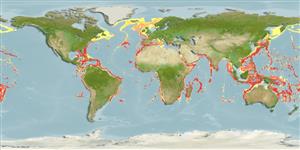Common names from other countries
Classification / Names / Names
俗名 | 同種異名 | Catalog of Fishes (gen., sp.) | ITIS | CoL | WoRMS
Environment: milieu / climate zone / depth range / distribution range
生態學
大洋性; 深度上下限 100 - 1750 m (Ref. 1695). ? - 10°C (Ref. 1695); 69°N - 32°S, 89°W - 160°W
Circumglobal in tropical and subtropical oceanic waters. Tropical to polar.
Length at first maturity / 大小 / 重量 / 年齡
Maturity: Lm ?, range 30 - ? cm Max length : 4.5 cm ML 雄魚/尚未辨別雌雄; (Ref. 1695)
Minimum depth from Ref. 106682. Rarely exceeds 4.5 cm ML (Ref. 1695).
Life cycle and mating behavior
成熟度 | 繁殖 | 產卵場 | 卵 | 孕卵數 | 仔魚
Members of the class Cephalopoda are gonochoric. Male and female adults usually die shortly after spawning and brooding, respectively. Mating behavior: Males perform various displays to attract potential females for copulation. During copulation, male grasp the female and inserts the hectocotylus into the female's mantle cavity where fertilization usually occurs. Life cycle: Embryos hatch into planktonic stage and live for some time before they grow larger and take up a benthic existence as adults.
主要參考資料
參考文獻 | 合作者 | 合作者
Jereb, P. and C.F.E. Roper (eds.). 2005. (Ref. 1695)
IUCN 瀕危狀態 (Ref. 130435: Version 2024-1)
無危 (LC) ; Date assessed: 29 March 2009
CITES狀態 (Ref. 108899)
Not Evaluated
Not Evaluated
人類使用
| FishSource |
工具
更多資訊
年龄/大小成長長度-重量長度-長度型態特徵仔魚豐度
網路資源
Estimates based on models
Preferred temperature
(Ref.
115969): 4.7 - 11.6, mean 7.1 (based on 951 cells).
瀕危性
Low vulnerability (10 of 100).
價格種類
Unknown.
